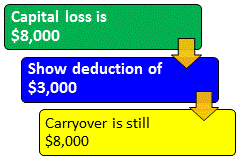Capital Loss Limitations for Partnerships and S Corporations
When it comes to investing in partnerships or owning shares in an S corporation, understanding the tax implications is essential. One crucial aspect that investors need to be aware of is the capital loss limitations imposed on these entities. Capital losses can have a significant impact on your overall tax liability and financial outcomes, so it’s important to understand how these limitations work.
In general, when partners or shareholders sell their partnership interest or S corporation stock at a loss, they may be able to deduct that loss against their other income. However, there are certain restrictions and limitations set by the Internal Revenue Service (IRS) that govern the amount of capital losses that can be claimed.
1. At-Risk Rules:
Partnerships and S corporations must adhere to what is known as “at-risk” rules when it comes to claiming capital losses. The at-risk rules help determine whether a partner or shareholder has enough personal financial risk in the entity to claim deductions for any losses incurred.
Under these rules, partners/shareholders can only deduct their share of partnership/S corporation losses up to the amount they have personally invested in the business venture. If their investment is fully at risk, then they can claim all allowable deductions against other income sources.
2. Basis Limitations:
Another limitation on capital losses stems from basis calculations. A partner’s basis in a partnership represents their economic interest in the entity and determines how much deductible loss they can claim.
The initial basis starts with cash contributions made by partners/shareholders but can also include property contributed or loans guaranteed by them for business purposes. Over time, basis adjustments occur due to various factors such as additional investments made or distributions received from profits.
If a partner/shareholder’s share of partnership/S corporation losses exceeds their adjusted basis, then they cannot deduct those excess losses immediately. Instead, those unclaimed losses get suspended and carried forward until there is sufficient basis available in the future to offset them.
3. Passive Activity Loss Limitations:
Partnerships and S corporations often engage in activities that are considered passive for tax purposes. Passive activities refer to business ventures where the partners/shareholders do not materially participate in day-to-day operations.
The IRS imposes additional limitations on claiming capital losses from passive activities. If a partner/shareholder’s loss arises from a passive activity, they can only deduct it against income derived from other passive activities or when they dispose of their entire interest in the partnership/S corporation.
4. At-Risk and Basis Reductions:
Under certain circumstances, a partner/shareholder may experience reductions in both at-risk amounts and basis calculations, which further limit their ability to claim capital losses.
For instance, if someone guarantees a loan taken by the partnership/S corporation, that guarantee increases their at-risk amount initially. However, if the entity defaults on the loan and the guarantor becomes personally liable for repayment, their at-risk amount reduces accordingly.
Similarly, if there are recourse debts owed by partnerships/S corporations that become uncollectible, partners/shareholders may face basis reductions equal to their share of those bad debts.
5. Special Considerations for S Corporations:
S corporations have an additional limitation known as “passive investment income” rules imposed on shareholders who own more than 10% of its stock. These rules prevent excessive passive income generated by investments held within an S corporation from being offset by capital losses claimed by shareholders against other sources of income outside of the entity.
If a shareholder’s capital losses exceed their net passive investment income (income generated through investments within the S corporation), then only part of those losses can be used to offset non-passive income like wages or interest earned elsewhere. The remaining excess loss is suspended until it can be absorbed through future passive investment income or upon disposition of all shares in the S corporation.
It is crucial for investors involved with partnerships or holding shares in S corporations to understand these limitations on capital losses. Consulting with a tax professional can help ensure accurate calculations and proper application of these rules, ultimately minimizing any adverse impact on your tax liability.
In conclusion, capital loss limitations for partnerships and S corporations exist to prevent excessive deductions that may not align with the actual financial risk or investment made by partners/shareholders. Understanding at-risk rules, basis limitations, passive activity loss restrictions, and other considerations will enable investors to navigate their tax obligations effectively while optimizing their investment strategies.

